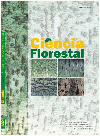
|
Ciência Florestal
Centro de Pesquisas Florestais - CEPEF, Departamento de Ciências Florestais - DCFL, Programa de Pós Graduação em Engenharia Florestal - PPGEF
ISSN: 0103-9954
EISSN: 0103-9954
Vol. 28, No. 2, 2018, pp. 758-764
|
 Bioline Code: cf18070
Bioline Code: cf18070
Full paper language: Portuguese
Document type: Research Article
Document available free of charge
|
|
|
Ciência Florestal, Vol. 28, No. 2, 2018, pp. 758-764
| pt |
USO DO GUAPURUVU ( Schizolobium parahyba  ) PARA FINS ENERGÉTICOS ) PARA FINS ENERGÉTICOS
Narita, Diego Kenji; Nakashima, Gabriela Tami; Róz, Alessandra Luzia da; Pires, Ariane Aparecida Felix & Yamaji, Fabio Minoru
Resumo
Uma alternativa como fonte para geração de energia é o uso de biocombustível sólido produzido pelo
processo de briquetagem. O briquete é produzido pela compactação de materiais lignocelulósicos,
possibilitando que haja maior energia em menor volume. O objetivo desse trabalho foi analisar a briquetagem
do Schizolobium parahyba (guapuruvu), avaliando-se a estabilidade, densidade, resistência mecânica e
friabilidade dos briquetes. Foram testados três granulometrias diferentes: tratamentos T1 (maior que 40
mesh), T2 (entre 40 e 60 mesh) e T3 (menor que 60 mesh), todos briquetados a um teor de umidade de 12%,
utilizando-se prensa hidráulica sem o uso de aquecimento nem aglutinante. Os três tratamentos diferiram
significativamente entre si quanto à densidade, expansão longitudinal e resistência à tração por compressão
diametral. A granulometria mais fina (T3) apresentou os melhores resultados para todos os parâmetros,
tendo os maiores valores para a densidade (0,932 g.cm-3) e resistência (0,485 MPa) e menor índice de
friabilidade (8,35%). Os resultados mostraram que a granulometria interfere nas características do produto
final. O estudo mostrou que o guapuruvu pode ser uma alternativa para a produção de biocombustível
sólido.
Palavras-chave
biomassa vegetal; bioenergia; granulometria; resíduos
|
| |
| en |
USE OF Schizolobium parahyba  FOR ENERGY PURPOSES FOR ENERGY PURPOSES
Narita, Diego Kenji; Nakashima, Gabriela Tami; Róz, Alessandra Luzia da; Pires, Ariane Aparecida Felix & Yamaji, Fabio Minoru
Abstract
The use of solid biofuel produced by the briquetting process is an alternative source for power generation.
The briquette is produced by the compression of lignocellulosic materials, allowing for a higher energy at
a lower volume. This work aimed to study the briquetting process of Schizolobium parahyba (guapuruvu).
It was evaluated the stability, density, mechanical resistance and friability of the briquettes. The treatments
were: T1 (above 40 mesh), T2 (between 40 and 60 mesh) and T3 (below 60 mesh). All treatments were
adjusted to a moisture content of 12%. The briquettes were produced by hydraulic press without using
heat or binder. The three treatments were statistically different from each other in terms of density, height
expansion and diametrical compression resistance. The treatment T3 showed the best results for all
parameters, with the highest values for density (0.932 g.cm-3) and mechanical resistance (0.485 MPa).
Also, T3 presented the lowest friability (8.35%). The results showed that the particle size interferes in the
final product characteristics. The study showed that guapuruvu could be an alternative for solid biofuel
production.
Keywords
vegetal biomass; bioenergy; particle size; residues
|
| |
© Copyright [2018] - Ciência Florestal
Alternative site location: http://cascavel.ufsm.br/revistas/ojs-2.2.2/index.php/cienciaflorestal/index
|
|
